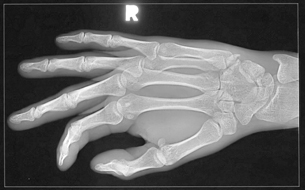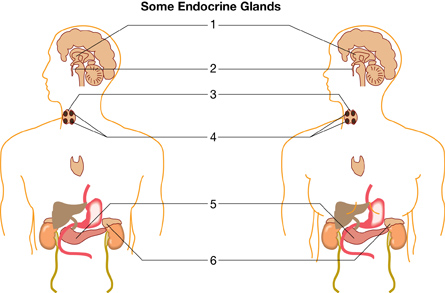Module 2
1. Module 2
1.30. Page 4
Module 2—The Endocrine System
Antagonistic Hormones Regulate Calcium Levels
 Read
Read
There are two antagonistic hormones (hormones that work in opposition to one another to establish overall balance or homeostasis) that regulate calcium levels in the blood. One of these hormones, calcitonin, originates from the thyroid gland. The other, parathyroid hormone, originates from the parathyroid glands.
 Self-Check
Self-Check
The following questions will help you to gain an understanding of where these hormones are secreted, how they maintain calcium homeostasis, how their secretion is regulated, and what happens when calcium balance is disrupted. The completed answers to these questions will become your notes for this part of Lesson 4. Therefore, complete your work carefully, and consult with your teacher if you have any questions. You may use library sources, the Internet, page 449 in your textbook, or any other resources to which you have access that will help you complete the questions. Check your answers and file your work in your course folder.
SC 12. Describe at least three functions of calcium in the body.
SC 13. Calcium homeostasis is mainly regulated by two hormones. Identify the two hormones and the glands that produce each of them.
SC 14. The two hormones that you identified in question SC 13 are described as being antagonistic hormones. Define what is meant by this.
SC 15. Describe the mechanism of calcitonin function.
SC 16. Outline the regulation of blood calcium levels by calcitonin.
Use the following additional information to answer questions SC 17, SC 18, SC 19, and SC 21.
| FMEN 1 patients often develop minute tumors in the parathyroid glands. This happened to Emily. Consequently, her parathyroid glands oversecrete parathyroid hormone. |
SC 17. Describe the overall effect of parathyroid hormone. Outline three specific actions on the body caused by this hormone to achieve its overall effect.

© Troy Kellogg/shutterstock
SC 18. Emily fell on a very icy sidewalk and broke some bones in her wrist. The bones were reset, but months later they still had not healed. During this time Emily was admitted to the emergency room of the hospital with severe abdominal pain, which was diagnosed as a case of kidney stones. Construct a hypothesis that may explain the underlying cause of both health problems. (Remember, a hypothesis should be in the form of an “If . . . then . . . because . . .” statement.)
SC 19. Draw a negative feedback loop that illustrates the regulation of blood calcium levels by parathyroid hormone.
SC 20. How would Emily’s feedback loop be different?
Following are ten multiple-choice questions and two numerical-response questions. Besides being good practice for the type of questions you will encounter on the Diploma Exam, they are good preparation for completing the lesson assessment. Check your answers and, if you do not understand any of the concepts, be sure to discuss them with your teacher.
Multiple-Choice Questions
Use the following diagram to answer questions SC 21 and SC 22.

SC 21. Which endocrine gland shown in the illustration would be directly responsible for the development of bone thinning if it was overproducing its hormones?
- 2
- 3
- 4
- 6
SC 22. Cretinism can develop if low secretions of hormone are produced by the gland labelled
- 2
- 3
- 4
- both 2 and 4
SC 23. Hypothyroidism developed in childhood would be characterized by
- impaired physical and mental development
- thirst and consumption of large volumes of water
- increased blood pressure and increased heart rate
- suppression of the immune system and the development of goitre
SC 24. The area of the brain that normally initiates the secretion of TSH is the
- medulla oblongata
- cerebrum
- pons
- hypothalamus
SC 25. A condition that results in an enlargement of the thyroid gland may be caused by a diet that is deficient in
- salt
- iron
- iodine
- sodium
Use the following information to answer questions SC 26, SC 27, and SC 28.
| Vegetables such as cabbage, rutabaga, and turnips contain goitrin, a substance that inhibits iodine uptake by the body. |
SC 26. A person with a diet that is high in vegetables containing goitrin may gain weight fairly rapidly. A possible explanation for this weight gain would be
- increased protein metabolism
- decreased blood sugar levels
- increased glycogen release
- decreased metabolic rate
SC 27. The function of which gland would be most affected by goitrin?
- anterior pituitary
- adrenal cortex
- thyroid gland
- parathyroid gland
SC 28. An increase in goitrin consumption would likely cause a person to experience increased
- fatigue
- heart rate
- breathing rate
- blood pressure
Use the following information to answer questions SC 29 and SC 30.
On April 26, 1986, a major accident occurred at a nuclear generating station in Chernobyl. The nuclear explosion dispersed several tons of radioactive iodine, cesium, uranium, and other elements five kilometers into the air.
Radioactivity is extremely damaging to living cells. From Biosphere 2000: Protecting Our Global Environment |
SC 29. As soon as people in Europe realized there had been a nuclear accident, they rushed to buy iodine tablets. What reason would people have for consuming large quantities of iodine?
- Iodine from the tablets, instead of the radioactive iodine, would accumulate in the thyroid.
- Iodine, by negative feedback, blocks the formation of TSH, therefore protecting the thyroid from radioactivity.
- Iodine inhibits cell division, thereby reducing the amount of cellular damage occurring during exposure to radiation.
- Iodine from the tablets could accumulate in the hypothalamus and block radioactivity from killing or altering body cells.
SC 30. In addition to symptoms of radiation poisoning, which symptoms would be expected among people who did not take iodine tablets?
- pancreatic dysfunction and insufficient insulin production
- metabolic dysfunction, resulting in fatigue and weight gain
- increased ACTH secretion and puffiness of face, chest, and abdomen
- pituitary dysfunction resulting in increased hGH secretion and development of gigantism
Numerical-Response Questions
Use the following information to answer question SC 31.
Some Glands and Hormones of the Human Body
Glands
Hormones
|
SC 31. Select a set of numbers for glands and hormones that correctly completes the statement below.
The ______ secretes ______, which stimulates the ______ to produce ______,
(gland) (hormone) (gland) (hormone)
which regulates metabolism (cellular respiration).
Use the following information to answer question SC 32.
Endocrine Glands
|
SC 32. Using the numbers that represent the endocrine glands shown above, match the hormone below to the endocrine gland that produces it.
Endocrine Gland: ________ ______ ______ _______
Hormone: Thyroxine PTH TSH Calcitonin
 Self-Check Answers
Self-Check Answers
SC 12. Functions of calcium include
- structure of bones in skeleton
- tooth development
- blood-clotting process
- synaptic transmission in nerve conduction
- muscle contraction
SC 13. Calcium homeostasis in the blood (plasma) is regulated by calcitonin, which is produced by the thyroid gland, and parathyroid hormone (sometimes called parathormone or PTH), which is produced by the parathyroid glands.
SC 14. Antagonistic hormones oppose or work opposite each other. Calcitonin decreases levels of calcium in the blood, whereas parathyroid hormone increases levels of blood calcium.
SC 15. Calcitonin decreases levels of blood calcium by stimulating uptake of calcium into the bones and by inhibiting certain bone cells (osteoclasts) from breaking down bone in the skeleton to release calcium.
SC 16. High levels of calcium in the blood stimulate the secretion of calcitonin, which increases the uptake of calcium into the bones and inhibits the decomposition of bone, thereby lowering calcium levels in the blood. Low calcium levels in the blood inhibit the secretion of calcitonin, which in turn decreases the uptake of calcium into the bones and allows the decomposition of bone to release more calcium into the blood. A negative feedback loop regulating blood calcium levels by calcitonin would resemble the following sample.

SC 17. The overall effect of PTH is to increase levels of calcium in the blood plasma. It does this by stimulating bone-decomposing cells (osteoclasts) to digest bone in the skeleton and release the calcium from this decomposed bone into the bloodstream; stimulating the kidneys to reabsorb more calcium, thereby decreasing the amount of calcium excreted in the urine, which consequently increases the levels of calcium in the blood; and stimulating cells in the intestines to increase the absorption of calcium from food, thereby increasing the levels of calcium in the blood. Vitamin D is required for the absorption of calcium from the intestines, and parathyroid hormone stimulates the activation of Vitamin D to accomplish this.
SC 18. The tumours in Emily’s parathyroid glands cause the hypersecretion of parathyroid hormone. Therefore, calcium is being constantly being released from her bones, making it very difficult for new bone tissue is to form. The result is that the bones in her wrist do not heal; and, furthermore, it is likely that her already weakened bones may have broken more easily due to the release of too much PTH.
Kidney stones are caused by the precipitation of excess calcium into crystals in the kidney tubules. Your hypothesis should resemble the following: If there is excess parathyroid hormone secreted into the blood, then excess calcium will be released into the blood because PTH stimulates the bones to release calcium, the kidneys to reabsorb more calcium from urine, and the intestines to absorb more calcium from food. Continued release of calcium from the bones will cause the bones to become less dense, more fragile, and more prone to breaks. The high levels of blood calcium may crystallize and plug small tubules, such as those in the kidneys, resulting in kidney stones.
SC 19. A negative feedback loop that illustrates the regulation of blood calcium levels by parathyroid hormone may resemble the following sample.

A diagram similar to “Figure 13.18” on page 449 of your textbook would also be acceptable.
SC 20. Emily’s feedback loop would be different because high levels of parathyroid hormone would not inhibit the bone cells from releasing calcium, the kidneys from reabsorbing the calcium, or the intestines from absorbing the calcium from food. All three actions would continue. A feedback loop may resemble the following sample.

SC 21. C
SC 22. D
SC 23. A
SC 24. D
SC 25. C
SC 26. D
SC 27. C
SC 28. A
SC 29. A
SC 30. B
SC 31. 1,7,3,5 (in this order)
SC 32. 4,5,2,4 (in this order)